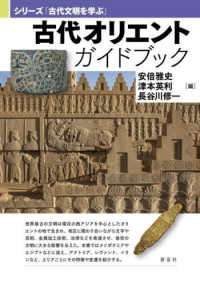- ホーム
- > 洋書
- > 英文書
- > Computer / Languages
Full Description
For courses in Java programming
Unparalleled breadth and depth of object-oriented programming concepts
The Deitels' groundbreaking How to Program series offers unparalleled breadth and depth of programming fundamentals, object-oriented programming concepts and intermediate-level topics for further study. Java How to Program, Early Objects, 11th Edition, presents leading-edge computing technologies using the Deitel signature live-code approach, which demonstrates concepts in hundreds of complete working programs. The 11th Edition presents updated coverage of Java SE 8 and new Java SE 9 capabilities, including JShell, the Java Module System, and other key Java 9 topics. [Java How to Program, Late Objects, 11th Edition also is available.]
Contents
Brief Contents
Introduction to Computers, the Internet and Java
Introduction to Java Applications; Input/Output and Operators
Introduction to Classes, Objects, Methods and Strings
Control Statements: Part 1; Assignment, ++ and -- Operators
Control Statements: Part 2; Logical Operators
Methods: A Deeper Look
Arrays and ArrayLists
Classes and Objects: A Deeper Look
Object-Oriented Programming: Inheritance
Object-Oriented Programming: Polymorphism and Interfaces
Exception Handling: A Deeper Look
JavaFX Graphical User Interfaces: Part 1
JavaFX GUI: Part 2
Strings, Characters and Regular Expressions
Files, Input/Output Streams, NIO and XML Serialization
Generic Collections
Lambdas and Streams
Recursion
Searching, Sorting and Big O
Generic Classes and Methods: A Deeper Look
Custom Generic Data Structures
JavaFX Graphics and Multimedia
Concurrency
Accessing Databases with JDBC
Introduction to JShell: Java 9's REPL
Chapters on the Web
Operator Precedence Chart
ASCII Character Set
Keywords and Reserved Words
Primitive Types
Using the Debugger
Appendices on the Web Index Online Chapters and Appendices
Swing GUI Components: Part 1
Graphics and Java 2D
Networking
Java Persistence API (JPA)
JavaServerTM Faces Web Apps: Part 1
JavaServerTM Faces Web Apps: Part 2
REST-Based Web Services
(Optional) ATM Case Study, Part 1: Object-Oriented Design with the UML
(Optional) ATM Case Study, Part 2: Implementing an Object-Oriented Design
Swing GUI Components: Part 2
Java Module System and Other Java 9 Features
Using the Java API Documentation
Creating Documentation with javadoc
Unicode®
Formatted Output
Number Systems
Bit Manipulation
Labeled break and continue Statements
UML 2: Additional Diagram Types
Design Patterns







